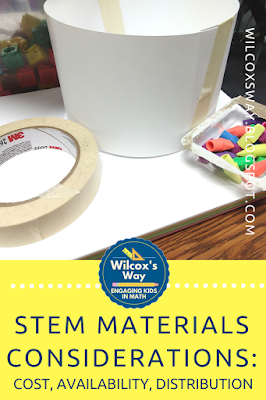Hopefully, after my last post you're excited to try a STEM challenge in your math classroom.....but maybe you're still a little nervous? Have no fear! Here are my top tips for successfully implementing STEM challenges in your classroom.
1. Try it yourself first
I know you may not be that excited about building a house from marshmallows and toothpicks or whatever the challenge is, but it really is helpful in many ways. It helps you understand different routes that students may take (although you'll still have students surprise you with something you didn't think of). You will also better understand what roadblocks students might hit, giving you a better idea of how to help them get "unstuck" without giving away too much. I also think it is great to build rapport with students, as you can commiserate with them about the problems you had. And maybe, just maybe, you'll have some fun once you get started! My son and I have had quite a bit of fun trying out my STEM ideas!
2. Consider materials carefully
This can be a helpful consideration both in choosing the STEM challenge, as well as how you implement it. Before you choose a STEM challenge, carefully consider the materials. If the materials don't seem like a good fit for your class, keep looking for a different challenge. You might also consider what materials you want to make available. For many STEM challenges, students are allowed to choose materials, so look over that supply list with a critical eye. Make thoughtful decisions about materials you don't want to use, or additional materials you want to make available. Here are some of the factors that affect my materials choice:
4. Consider group size carefully
There is no perfect group size for STEM challenges. The perfect size depends on what students are being asked to do. Think carefully about how many students can be actively involved in the challenge. The perfect group size for STEM challenges (and almost anything!) is one where you have enough people to do the work and get ideas, but not so many that people get uninvolved. One of my STEM challenges involves students building a scoop for cereal. For this one, I like to use pairs. Two people are plenty to design a scoop and measure the contents. For a different STEM challenge where students are building a pool large enough to land a high diver, I like larger groups. There is more to do during testing, so larger groups make more sense.
1. Try it yourself first
I know you may not be that excited about building a house from marshmallows and toothpicks or whatever the challenge is, but it really is helpful in many ways. It helps you understand different routes that students may take (although you'll still have students surprise you with something you didn't think of). You will also better understand what roadblocks students might hit, giving you a better idea of how to help them get "unstuck" without giving away too much. I also think it is great to build rapport with students, as you can commiserate with them about the problems you had. And maybe, just maybe, you'll have some fun once you get started! My son and I have had quite a bit of fun trying out my STEM ideas!
2. Consider materials carefully
This can be a helpful consideration both in choosing the STEM challenge, as well as how you implement it. Before you choose a STEM challenge, carefully consider the materials. If the materials don't seem like a good fit for your class, keep looking for a different challenge. You might also consider what materials you want to make available. For many STEM challenges, students are allowed to choose materials, so look over that supply list with a critical eye. Make thoughtful decisions about materials you don't want to use, or additional materials you want to make available. Here are some of the factors that affect my materials choice:
- Are they affordable in the amount I will need?
- Are the materials easy to find?
- Are they easy to store after finished?
- Can I save the extras for later use?
- Can my students handle using them appropriately?
- Am I going to be left with a mess?
3. Consider materials distribution carefully
Make sure you think this through before you start. Disorganized materials distribution can sour the whole experience for you, so take the time to plan this carefully so it won't drive you crazy.
Make sure you think this through before you start. Disorganized materials distribution can sour the whole experience for you, so take the time to plan this carefully so it won't drive you crazy.
- Are you going to give all students a set of the exact same materials?
- Are you going to set out the materials and give students free access?
- Will there be one person in the group that is in charge of getting materials for the group?
- If students have extra materials, should they return them immediately or at the end of the challenge?
- Can students get materials whenever they are ready, or will you call groups to get materials one at a time?
There is no perfect group size for STEM challenges. The perfect size depends on what students are being asked to do. Think carefully about how many students can be actively involved in the challenge. The perfect group size for STEM challenges (and almost anything!) is one where you have enough people to do the work and get ideas, but not so many that people get uninvolved. One of my STEM challenges involves students building a scoop for cereal. For this one, I like to use pairs. Two people are plenty to design a scoop and measure the contents. For a different STEM challenge where students are building a pool large enough to land a high diver, I like larger groups. There is more to do during testing, so larger groups make more sense.
5. Consider the best timing to incorporate any math you want to work into the challenge
If part of your purpose for the STEM challenge is for students to incorporate a math concept, think carefully about whether it will be more effective before or after the challenge. For one STEM challenge that I did, students had to build a structure that had a base with a particular area. In that case, it was important that students had a strong foundation regarding square inches and area before they started. In another case, students were graphing inequalities on a number (showing that all acceptable results were below a particular value). In this instance, I chose to teach graphing inequalities on a number line after we did the STEM challenge, as I felt that students would have greater buy-in with their own data to use.
6. Decide in advance how you will hold students accountable
Personally, I like to begin and end every STEM challenge with students working individually. After I pose a STEM challenge, I always give students a few minutes to write down their thoughts about the challenge before they begin work with their group. This holds students accountable, but also means that when groups begin working together, every student should have ideas to contribute. I end every STEM challenge with students reflecting about the how successful their group was and how well they worked together. Your accountability may look different, but I would definitely encourage you to have each student be responsible for something on their own.
7. Decide what you want students to do when they finish
Your classroom is going to be a busy place, and the last thing you need is groups of students wandering around, messing with students that are still working. Make sure that students know what to do when they are done. This is a great time for students to reflect on their group work, or to do some math that goes along with their challenge. You will also want to make sure that students take time to clean up their area.
8. Accept that your classroom is going to be louder than normal when you do a STEM challenge
If you know to expect this, it is a little easier to accept. For me, I have grown to love this aspect of STEM challenges (within reason 🙂). I love to hear the excitement in my students' voices as they explain to a group member their idea. I love to hear their cheers when they finally get something to work after many tries. I love that students are having fun and learning, so I have learned to accept the noise!
Now that you have this information, I encourage you to give STEM challenges a try. Comment below and tell what you tried and how it went.



